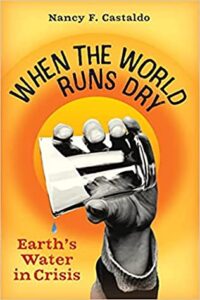When the World Runs Dry
Nancy F. Castaldo
Algonquin Young Readers
Published January 18, 2022
Amazon | Bookshop | Goodreads
About When the World Runs Dry
What would you do if you turned on the faucet one day and nothing happened? What if you learned the water in your home was harmful to drink? Water is essential for life on this planet, but not every community has the safe, clean water it needs. In WHEN THE WORLD RUNS DRY, award-winning science writer Nancy Castaldo takes readers from Flint, Michigan, and Newark, New Jersey, to Iran and Cape Town, South Africa, to explore the various ways in which water around the world is in danger, why we must act now, and why you’re never too young to make a difference.
Topics include: Lead and water infrastructure problems, pollution, fracking contamination, harmful algal blooms, water supply issues, rising sea levels, and potential solutions.
My Review
If you’ve been following my blog awhile, you have probably seen some other climate-slash-water-slash-pollution books come through my review listings. Hopefully I’ll be doing a whole list post featuring those kinds of books in early April to get ready for Earth Day, so they’ll all be listed in one place then.
This book, WHEN THE WORLD RUNS DRY had a lot of great information exploring various causes of water crisis– too little water, too much water, contaminated water, border issues, etc. So it took a slightly different approach than the other books that I’ve read. Each chapter is devoted to a specific kind of water crisis, which made the book really easy to follow. Each chapter explores case studies of communities faced with the type of water crisis talked about in the chapter, so there are real examples of communities dealing with these issues. Some of them I recognized from news headlines, while others were completely new to me.
I thought the case studies were well-presented. They included a lot of facts and information without being overwhelming or too data-heavy. Though I’d read books on similar topics in the past, there was a lot of new information in this book that I hadn’t come across before, so that was really helpful, too. I liked that the chapters often talked about activists or new legislation that was making a difference in the issue. The last chapter focuses on what can be done to help. So, the book definitely works to include positivity and hope, which I appreciated as well.
WHEN THE WORLD RUNS DRY had some overlap with a couple of the other books on water or the environment that I’ve read recently, namely THE STORY OF MORE by Hope Jahren and TRASHING THE PLANET by Stuart A. Kallen. There’s also a section in the book that covers the water crisis in Flint, Michigan, which I also read about in POISONED WATER by Candy J. Cooper and Marc Aronson. Those books were also really worth checking out if this is a topic that interests you.
I also recommend WHEN THE WORLD RUNS DRY. I think it’s a great look across the board at a lot of different types of water crises, examples of them in different communities, and what we can do to help.
Content Notes
Recommended for Ages 10 up.
Representation
The book includes case studies and personal stories from BIPOC.
Profanity/Crude Language Content
None.
Romance/Sexual Content
None.
Spiritual Content
Brief mentions of spiritual ceremonies.
Violent Content
Brief mention of a protest in which someone chained himself to a bulldozer and was arrested.
Drug Content
None.
Note: This post contains affiliate links, which do not cost you anything to use, but which help support this blog. I received a free copy of WHEN THE WORLD RUNS DRY in exchange for my honest review.
